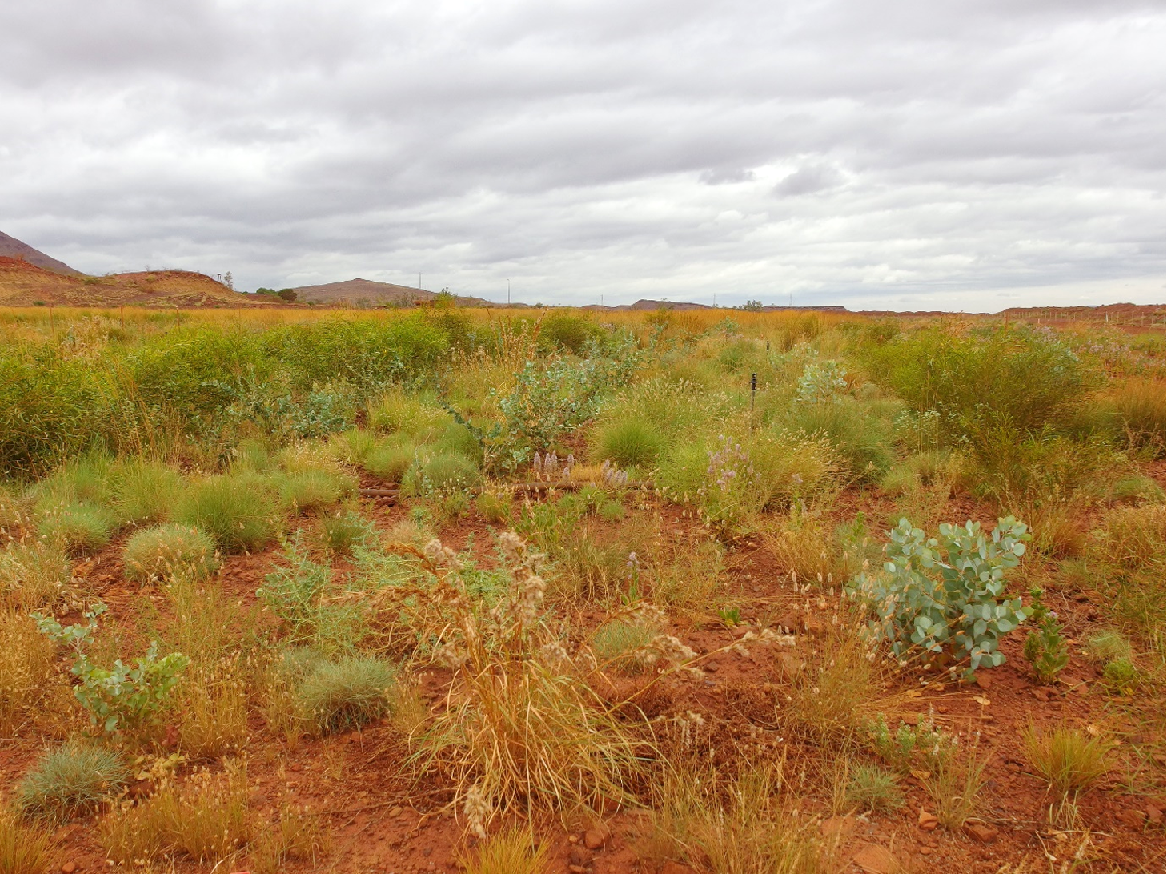Just add water: exceptional plant recruitment in arid zone mine rehabilitation
Rachel J. Standish A * , Todd E. Erickson B , Jonathan Fisher C and Tim K. Morald A
A * , Todd E. Erickson B , Jonathan Fisher C and Tim K. Morald A
A
B
C
Keywords: ecological restoration, iron ore mining, low rainfall, persistent soil seed bank, Pilbara, revegetation, seed dormancy, seedling establishment.
Global extraction of precious metals has reached unprecedented levels and continues to rise with the transition from fossil fuels to renewable energy sources. Mining activity in the Pilbara region of Western Australia is among the highest in the world (Luckeneder et al. 2021). The industry is under increasing societal pressure to mitigate the environmental impacts of mining, and this includes addressing the legacies of past mining activity. Ever more, successful mine rehabilitation and closure is imperative for social licence to mine iron ore and other minerals in the region. Since 2008, BHP Western Australia Iron Ore has partnered with scientists to research improvements in rehabilitation outcomes focusing on seed biology and management in the first instance (Erickson et al. 2017).
Rehabilitation of arid-zone ecosystems is challenging; a global meta-analysis estimated that less than 10% of sown seeds establish into plants (Shackelford et al. 2021). This is due in part to complex seed dormancy mechanisms that are prevalent among arid-zone flora. In the Pilbara, at least 70% of species have dormant seeds (Erickson et al. 2017). This trait has likely evolved as a strategy to sit-and-wait for large episodic rainfall events that facilitate seedling recruitment (Erickson et al. 2017). Small-seeded species, including eucalypts, tend not to establish from direct and broadcast seeding efforts in arid regions (Shackelford et al. 2021). In the case of eucalypts, other factors including seed predation by ants and lack of a persistent soil seed bank can limit recruitment (e.g. Wellington and Noble 1985). Establishing these species may require people to plant nursery-grown seedlings despite hot temperatures and water stress that characterise rehabilitation sites. The one available field study suggests planted seedlings will establish if water is available to them (T. Erickson, unpubl. data).
Here we report the successful establishment of native vegetation following rehabilitation and irrigation to simulate summer pulse-rainfall events of a former mine overburden and iron ore storage facility (Fig. 1). The observations are remarkable for two reasons. One, woody species have successfully established from nursery-grown planted seedlings, which is rarely documented for Pilbara mine rehabilitation. In January 2024, we planted 102 Eucalyptus leucophloia Brooker (snappy gum) seedlings, irrigated them to simulate pulse-rainfall events typical of the Yandi region (Bureau of Meteorology 2023). Nineteen events totalling 352 mm, and ranging from 2 mm to 38 mm, were delivered between 1 day and up to 17 days apart between 1 February and 30 May 2024. Two months later, 34 seedlings (33%) had survived and 8 months later, 25 seedlings (25%) had established.
Vegetation 1 year after rehabilitation at Yandi in the Pilbara region of Western Australia, including planted snappy gum, sown* and, volunteer species (Table 1). *Acacia ancistrocarpa Maiden & Blakely, A. inaequilatera Domin, Triodia pungens R.Br., T. wiseana C.A.Gardner were hand sown, and T.vanleeuwenii B.M.Anderson & M.D.Barrett was direct seeded. Photo: RJ Standish, Feb 2025.

Second, the unassisted recruitment of a diversity of native species is promising for future rehabilitation efforts (Table 1). The site had been used as a storage facility for overburden and ore for at least 20 years prior to its rehabilitation. After removal of the overburden and ore stockpiles, the site was deep ripped, cross ripped, deep ripped again and graded. Fresh topsoil was not added because of limited availability and concern about spreading exotic invasive buffel grass (Cenchrus ciliaris L.). The irrigation, coupled with summer rain, has triggered native plant species to recruit from wind-dispersed seeds and the remnant soil seed bank on site (Fig. 1). Comparatively few weeds recruited (Table 1). The remarkable observation is not that irrigation and rainfall triggered plant recruitment, but rather that there was potential for high-diversity native plant establishment in the absence of fresh topsoil.
| Species | Family | Species | Family | |
|---|---|---|---|---|
| Trianthema triquetrum Willd. | Aizoaceae | Senna glutinosa subsp. ×luerssenii (Domin) Randell | Fabaceae | |
| *Aerva javanica (Burm.f.) Schult. | Amaranthaceae | Senna glutinosa subsp. pruinosa (F.Muell.) Randell | Fabaceae | |
| Gomphrena cunninghamii (Moq.) Druce | Amaranthaceae | Senna notabilis (F.Muell.) Randell | Fabaceae | |
| Ptilotus astrolasius F.Muell. | Amaranthaceae | Abutilon sp. Mill | Malvaceae | |
| Ptilotus calostachyus F.Muell. | Amaranthaceae | Corchorus lasiocarpus Halford | Malvaceae | |
| Ptilotus exaltatus Nees | Amaranthaceae | Sida fibulifera Lindl. | Malvaceae | |
| Ptilotus gomphrenoides Benth. | Amaranthaceae | Eucalyptus sp. L’Hér. | Myrtaceae | |
| Cynanchum floribundum R.Br. | Apocynaceae | Boerhavia coccinea Mill. | Nyctaginaceae | |
| Lepidium sp. L. | Brassicaceae | Boerhavia schomburgkiana Oliv. | Nyctaginaceae | |
| Dysphania rhadinostachya (F.Muell.) A.J.Scott subsp. rhadinostachya | Chenopodiaceae | Aristida inaequiglumis Domin | Poaceae | |
| Salsola australis R.Br. | Chenopodiaceae | *Cenchrus ciliaris L. | Poaceae | |
| Arivela viscosa (L.) Raf. | Cleomaceae | Cymbopogon ambiguous (Hack.) A.Camus | Poaceae | |
| Ipomoea muelleri Benth. | Convolvulaceae | *Cynodon dactylon (L.) Pers. | Poaceae | |
| Euphorbia biconvexa Domin | Euphorbiaceae | Dactyloctenium radulans (R.Br.) P.Beauv. | Poaceae | |
| *Euphorbia hirta L. | Euphorbiaceae | Enneapogon caerulescens (Gaudich.) N.T.Burb. | Poaceae | |
| Acacia bivenosa DC. | Fabaceae | Enneapogon polyphyllus (Domin) N.T.Burb. | Poaceae | |
| Acacia colei Maslin & L.A.J.Thomson | Fabaceae | Enneapogon robustissimus (Domin) N.T.Burb. | Poaceae | |
| Acacia dictyophleba F.Muell. | Fabaceae | Eragrostis dielsii Pilg. | Poaceae | |
| Acacia pyrifolia DC. | Fabaceae | Eriachne aristidea F.Muell. | Poaceae | |
| Alysicarpus muelleri Schindl. | Fabaceae | Paspalidium basicladum Hughes | Poaceae | |
| Indigofera linnaei Ali | Fabaceae | Sporobolus australasicus Domin | Poaceae | |
| Petalostylis labicheoides R.Br. | Fabaceae | Triodia epactia S.W.L.Jacobs | Poaceae | |
| Rhynchosia australis Benth. | Fabaceae | *Rumex vesicarius L. | Polygonaceae | |
| Senna artemisioides subsp. oligophylla (F.Muell.) Randell | Fabaceae |
Exotics are marked with an asterisk. Species authorities according to the Western Australian Herbarium (1998–). Western Australian Herbarium (1998–). Florabase – the Western Australian flora. Department of Biodiversity, Conservation and Attractions. https://florabase.dbca.wa.gov.au/ (accessed 6 March 2025).
Snappy gum is characteristic of spinifex grasslands throughout the region. While irrigation is not feasible for large-scale rehabilitation, it may be warranted on smaller scales to establish snappy gum and other woody species in mine rehabilitation. The unassisted recruitment of native plant species indicates the possibility of mine rehabilitation in the absence of fresh topsoil and with rainfall to trigger seed germination and facilitate vegetation establishment.
Declaration of funding
This research was funded by the Cooperative Research Centre for Transformations in Mining Economies as part of Project 4.6 ‘Evidence for effective climate-adapted seed-sourcing strategies’.
Acknowledgements
Thanks to Evelyn Geurts, Leah Seabourne, Emma Stock, Shane Bisby and the Banjima Land Rehabilitation Partnership for their assistance with this research. We acknowledge the Chief Investigators, Rebecca Jordan, Suzanne Prober, Martin Breed, Jake Robinson and Siegy Krauss, and Industry Partners on the larger Project 4.6.
References
Bureau of Meteorology (2023) Climate data online. Australian Government Bureau of Meteorology, Melbourne, Victoria. Available at http://www.bom.gov.au/climate/data/ [accessed 25 January 2024]
Erickson TE, Mũnoz-Rojas M, Kildisheva OA, Stokes BA, White SA, Heyes JL, Dalziell EL, Lewandrowski W, James JJ, Madsen MD, Turner SR, Merritt DJ (2017) Benefits of adopting seed-based technologies for rehabilitation in the mining sector: a Pilbara perspective. Australian Journal of Botany 65, 646-660.
| Crossref | Google Scholar |
Luckeneder S, Giljum S, Schaffartzik A, Maus V, Tost M (2021) Surge in global metal mining threatens vulnerable ecosystems. Global Environmental Change 69, 102303.
| Crossref | Google Scholar |
Shackelford N, Paterno GB, Winkler DE, Erickson TE, Leger EA, Svejcar LN, Breed MF, Faist AM, Harrison PA, Curran MF, Guo Q, Kirmer A, Law DJ, Mganga KZ, Munson SM, Porensky LM, Quiroga RE, Török P, Wainwright CE, Abdullahi A, Bahm MA, Ballenger EA, Barger N, Baughman OW, Becker C, Lucas-Borja ME, Boyd CS, Burton CM, Burton PJ, Calleja E, Carrick PJ, Caruana A, Clements CD, Davies KW, Deák B, Drake J, Dullau S, Eldridge J, Espeland E, Farrell HL, Fick SE, Garbowski M, de la Riva EG, Golos PJ, Grey PA, Heydenrych B, Holmes PM, James JJ, Jonas-Bratten J, Kiss R, Kramer AT, Larson JE, Lorite J, Mayence CE, Merino-Martín L, Miglécz T, Milton SJ, Monaco TA, Montalvo AM, Navarro-Cano JA, Paschke MW, Peri PL, Pokorny ML, Rinella MJ, Saayman N, Schantz MC, Parkhurst T, Seabloom EW, Stuble KL, Uselman SM, Valkó O, Veblen K, Wilson S, Wong M, Xu Z, Suding KL (2021) Drivers of seedling establishment success in dryland restoration efforts. Nature Ecology & Evolution 5, 1283-1290.
| Crossref | Google Scholar | PubMed |
Wellington AB, Noble IR (1985) Seed dynamics and factors limiting recruitment of the mallee Eucalyptus incrassata in semi-arid, South-eastern Australia. Journal of Ecology 73, 657-666.
| Crossref | Google Scholar |


